10 Math Intervention Programs to Consider in 2026
reviewed by Jo-ann Caballes
Updated on December 26, 2025
There are plenty of math intervention programs, which makes it difficult for parents to choose the right one. In this guide, I’ve reviewed the top options and ranked them based on their features, pros, and cons to help you decide on the best support for your child. As a math teacher, I’ve personally used these platforms before recommending them.
Key points
- Brighterly offers 1:1, individualized math instruction and game-driven practice with professional teachers to drive real results.
- Mathematics intervention programs for blended instruction and practice include DreamBox, MobyMax, Mathnasium, Khan Academy, and Mathlinks: Essentials.
- Math intervention resources that focus on problem-solving include IXL, XtraMath, Pirate Math Equation Quest, and Freckle.
What is math intervention?
Math intervention is targeted support specifically designed to help students struggling with math build missing skills and improve understanding. It’s based on structured instruction, continuous practice, and progress monitoring. The purpose is to address learning gaps, enhance self-esteem, and meet grade-level mathematics expectations.
Math intervention is usually delivered 1:1 or in small groups. As it comes from its definition, this study mode differs from special education. Specifically, math interventions are meant to be short- to medium-term and to serve students with no identified disabilities. For comparison, special education applies to long-term strategies for children with learning disabilities that require an Individualized Education Program (IEP). Still, some programs might cover both.
Math intervention curriculum: What are the 10 signs your child needs it?
- Difficulty understanding basic math concepts
- Inability to explain the logic behind problems
- Slow or inaccurate fact recall
- Deteriorating performance on tests
- Falling behind peers in the classroom
- Frequent annoyance with homework
- Lack of confidence when dealing with math-related tasks
- Avoidance of math-associated activities for school or in life
- Frustration and anxiety associated with math
- Trouble applying math concepts in everyday situations
What is the best math intervention program?
The best math intervention programs are research-based, personalized, and adapted to each child’s specific learning weaknesses and needs. They offer clear instruction, engaging lessons, support from qualified math professionals, and regular progress tracking. They adopt a comprehensive approach that not only solidifies skills but also works on boosting confidence.
While there are many reading intervention programs available to parents and students, the choice of platforms targeting math knowledge and skills is relatively limited. Still, during my career, I’ve come across a number of good options that I’m sharing with you.
So, what are good math intervention programs that meet these requirements?
Best math intervention programs
- Brighterly
- DreamBox
- MobyMax
- Mathnasium
- IXL
- XtraMath
- Pirate Math Equation Quest
- Khan Academy
- Mathlinks: Essentials
- Freckle
Paid online math intervention programs: Comparison
- Brighterly
- DreamBox
- MobyMax
- Mathnasium
- IXL
| Important features | Grade levels | Personalization | Cost | |
Brighterly |
Award-winning curriculum STEM focus Fully adaptive learning plan Professional math teachers |
1-9 |
✅ (teacher-led) |
From $17.30/lesson Free first session Free math worksheets Free math tests |
DreamBox |
Adaptive learning Gamification & interactivity |
PreK-8 |
✅ (tech-driven) |
From $12.95/month 14-day free trial |
MobyMax K-8 math intervention program |
Differentiated learning Adaptive placement test |
K-8 |
✅ (teacher or parent-driven) |
From $7.99/month 30-day free trial |
Mathnasium |
In-center & online tutoring Tailored learning |
K-12 |
✅ (teacher-led) |
From $25-$35/session Free assessment |
IXL |
Standard video instruction Lots of math practice questions |
K-12 |
✅ (tech-driven) |
$9.95/month 30-day satisfaction guarantee |
Free math intervention programs: Comparison
- XtraMath
- Pirate Math Equation Quest
- Khan Academy
- Mathlinks: Essentials
- Freckle
| Important features | Grade levels | Personalization | |
XtraMath |
Timed fact practice Awards |
K-8 |
✅ (tech- or teacher/parent-driven) |
Pirate Math Equation Quest |
Structured process for word-problem solving Prerecorded video instructions Practice questions |
3rd grade only | ❌ |
Khan Academy math intervention programs free |
Comprehensive topic coverage Self-paced lessons & practice Full grade availability |
PreK-12 | ❌ |
Mathlinks: Essentials |
Detailed instruction Grade-organized packets |
6-9 |
✅ (teacher or parent-driven) |
Freckle |
Adaptive practice 70,000+ math problems |
K-12 |
✅ (tech-driven) |
#1 Brighterly math intervention program
Age group: 1-9 grade
Best for: 1:1, personalized mathematics tutoring by professional teachers
Brighterly is a truly personalized math intervention program that is based on real-time, online tutoring. Unlike other platforms, Brighterly is constructed on the idea that human teachers are crucial for the academic success of all students, whether they need intervention or not. Gamification is also incorporated in line with modern teaching methodologies and research-based, data-backed, evidence-supported practices.
Brighterly reading and math intervention programs: Features
Fully customized learning path
The Brighterly math and reading platform stands out with the from-scratch personalization of the learning plan and materials for every single child. It all starts with a careful evaluation of the student’s needs, strengths, weaknesses, and knowledge gaps. Parents are involved in the preparation process as they best know their kid’s requirements.
Meanwhile, the math program is STEM-focused and follows the US state standards for alignment with the education system across the nation. It covers both core and advanced topics in algebra and geometry so that it can adapt to the current level of each child and also meet their future goals and aspirations.
Brighterly intervention tutoring helps whether your child attends a public school or is homeschooled. That’s because teachers are able to adjust their methods in real time based on the students’ responses.
The high level of customization is praised by parents in their reviews on Trustpilot. As a result, kids can quickly improve their knowledge and skills, and they even start enjoying the previously hated math subject.
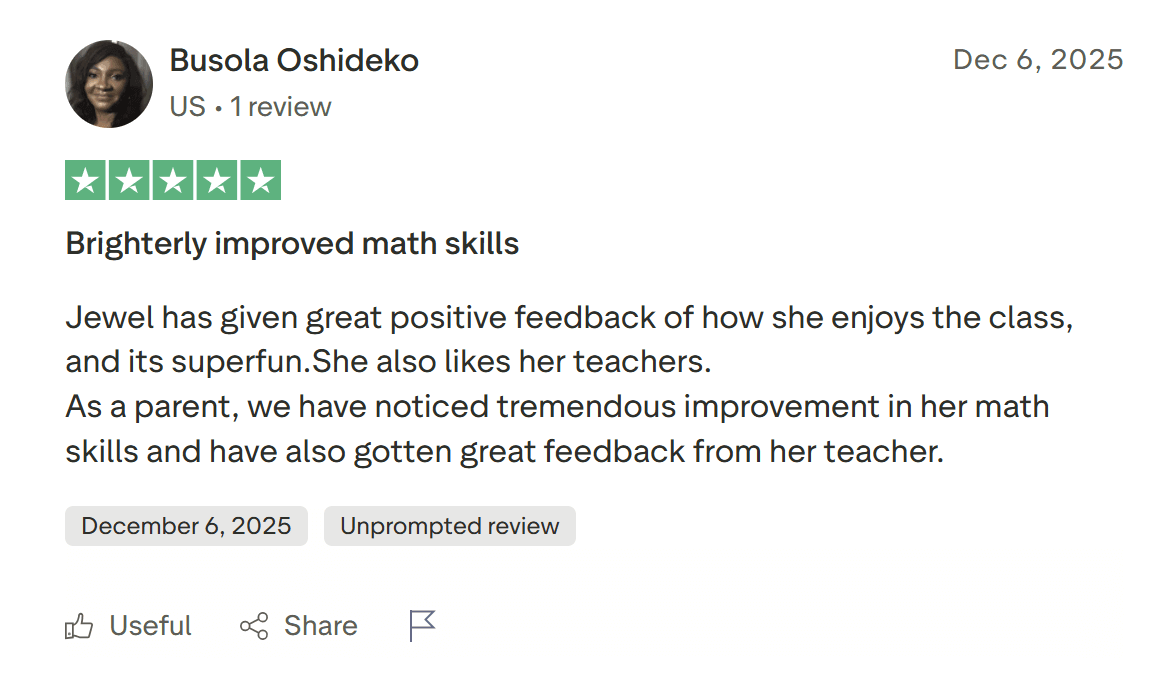
By the way, Brighterly offers both reading and math intervention programs if your child needs both.
Highly qualified math teachers
Another feature that makes Brighterly one of the top math intervention programs for grades 1-9 is the full-time presence of human teachers. In my experience, I’ve seen how important it is to involve real teachers when supporting children with challenges.
Moreover, all Brighterly math tutors hold a Bachelor’s or Master’s degree in math and have been teaching for at least 5-10 years. They are trained in pedagogy to tailor their teaching methodology to the diverse needs of students who require intervention.
Additionally, math tutors obtain excellent personal skills, as repeated over and over again on Trustpilot. They are generally described as professional, knowledgeable, kind, patient, caring, and adaptive.
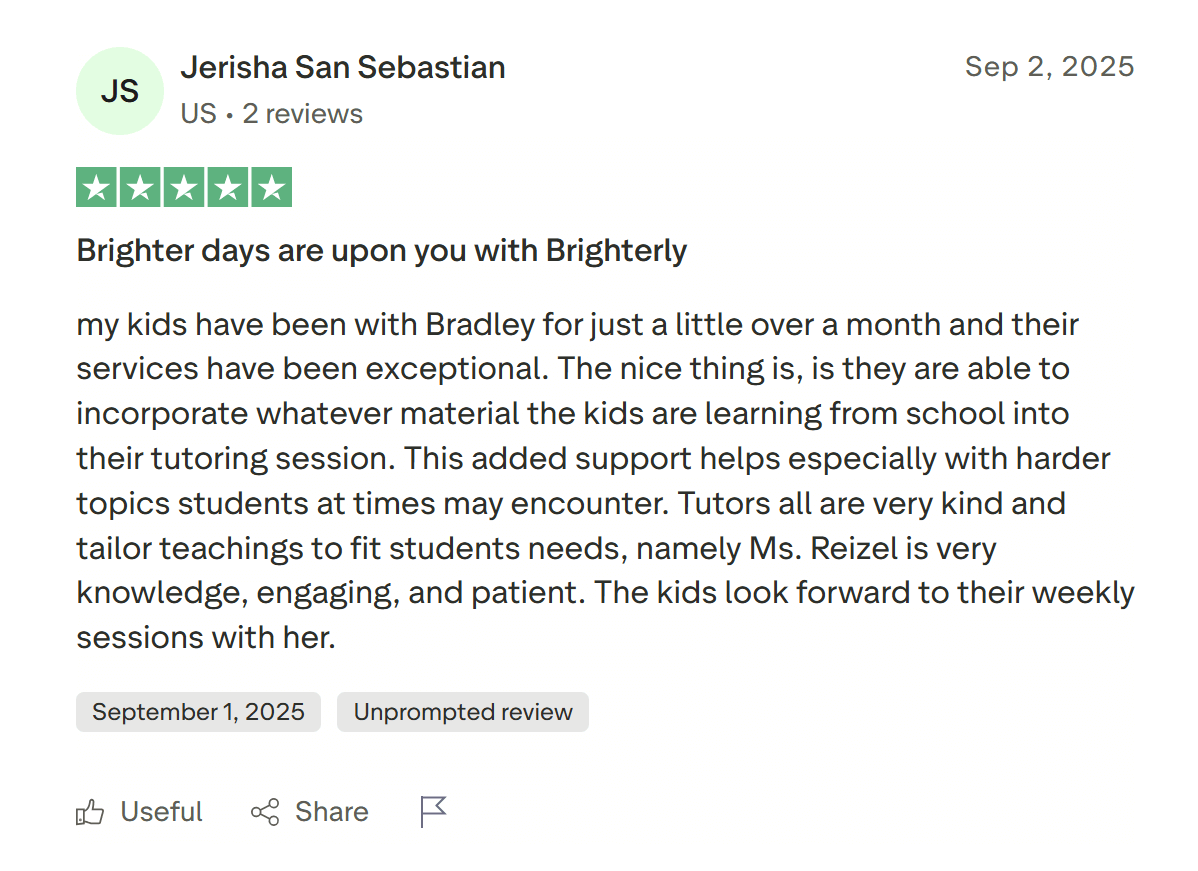
Free, specialized resources
On top of that, students and their parents can use math worksheets free of charge. The online and printable worksheets are organized by grade level and math topic for easy searchability and usability. They feature nice pictures and real-world examples to make learning more entertaining and down-to-earth, which is essential for kids who require intervention.
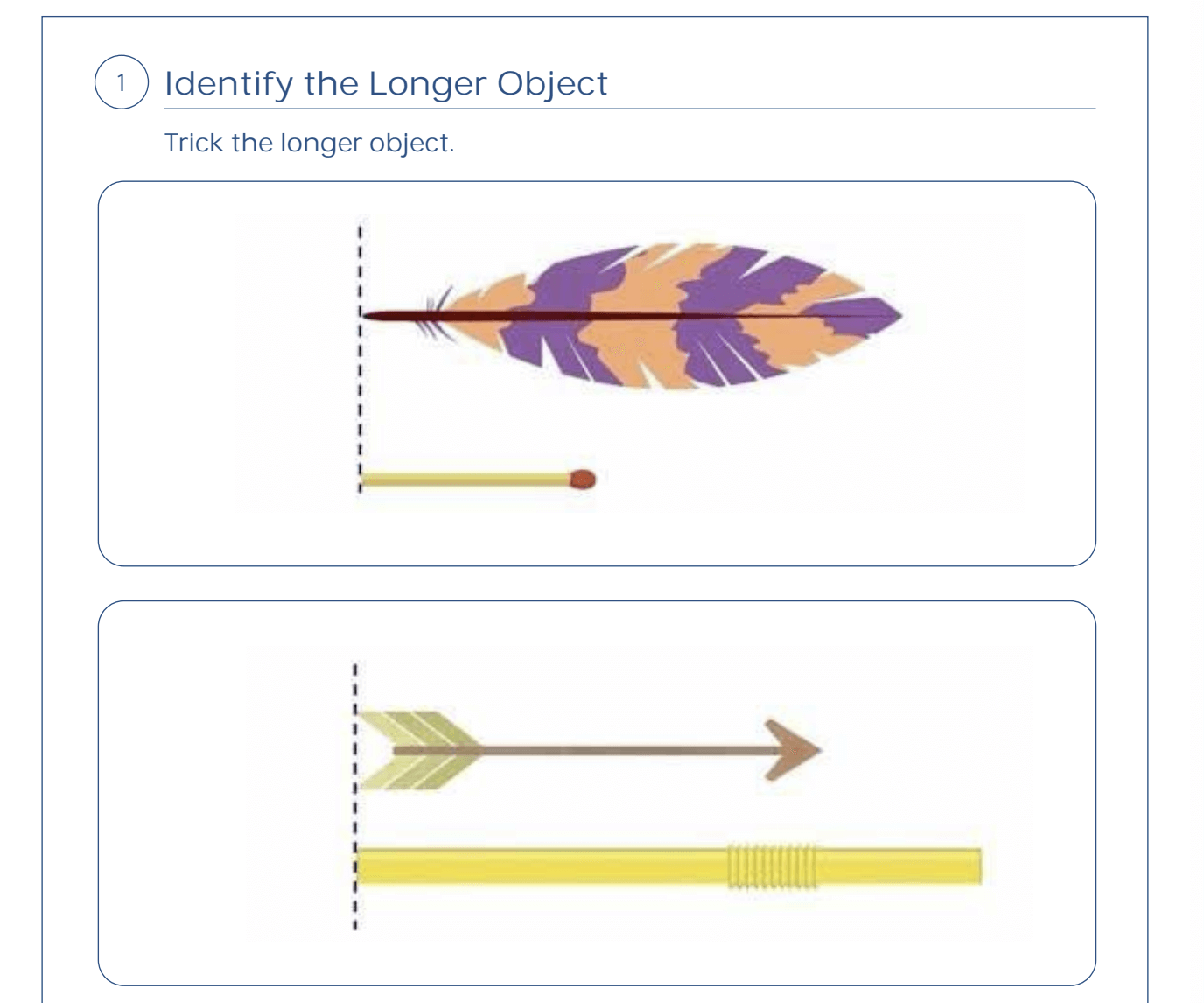
You can also use the free math tests to assess your child’s level and decide in which areas they need the most support. In this way, you can choose the best math intervention program and type of support.
Brighterly pricing
- 1-month membership: From $20.70/lesson
- 3-month membership: From $20.20/lesson
- 6-month membership: From $19.40/lesson
- 12-month membership: From $17.30/lesson
The Brighterly pricing is affordable, starting at $17.30/lesson. This price, which comes with a 12-month subscription for 3 lessons/week, is well below the US average tutoring rates per hour of $20-$80. Also, each student gets a first free lesson.
Brighterly pros |
Brighterly cons |
| ✅Fully customized intervention math curriculum | ❌Requires good internet connection |
| ✅Educational and emotional support by trained teachers | ❌No offline lesson availability |
| ✅Fusion of real teacher instruction with gamification |
That said, the average Trustpilot score of Brighterly reaches 4.4, showcasing the platform’s brilliant reputation and reliability.
#2 DreamBox math intervention program
Age group: PreK-8 grade
Best for: Adaptive, game-like personalized math practice for elementary and middle school

Based on DreamBox reviews, this is one of the most popular evidence based math intervention programs that adapts learning in real time based on a student’s progress. The math app for kids provides interactive, game-based lessons and activities that are dynamically adjusted.
DreamBox adaptive math intervention program: Features
- Intelligent Adaptive Learning for motivating experiences
- Real-time customized lessons
- Targeted support for core skills
DreamBox pricing
- 1-month subscription: $12.95
- 6-month subscription: $59.95
- 12-month subscription: $99.95
- Lifetime subscription: $150
DreamBox Math comes with a 14-day free trial. Family plans are available at discounted rates if you have a few children.
DreamBox pros |
DreamBox cons |
| ✅Self-paced progress | ❌Not full curriculum |
| ✅Engaging math lessons | ❌No teacher-led instruction |
| ✅User-friendly app | ❌Limited use beyond middle school |
#3 MobyMax math intervention program
Age group: K-8 grade
Best for: Identifying and working on missing math skills
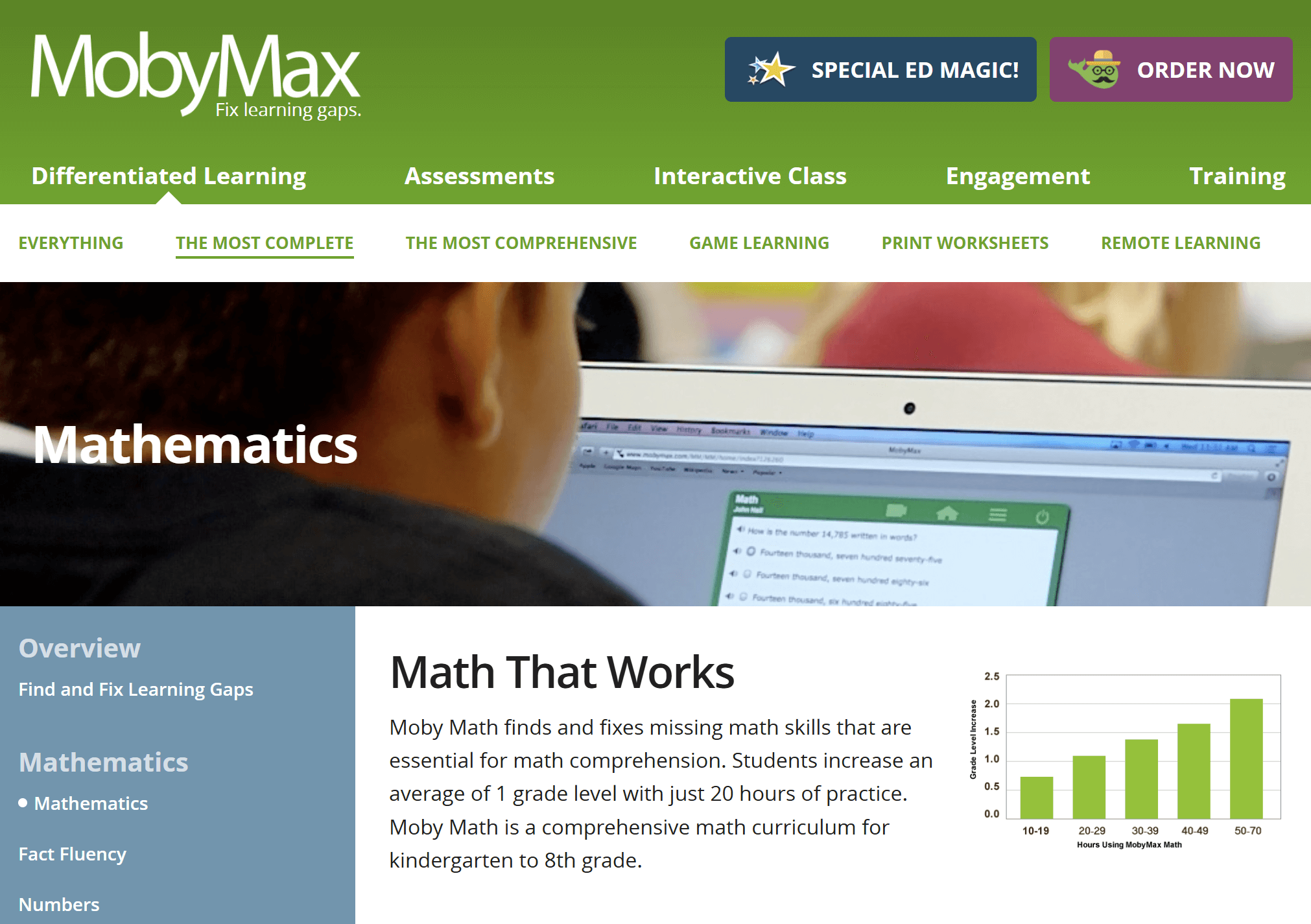
MobyMax is an adaptive math intervention program based on an initial assessment to identify specific knowledge gaps and focus on them. The platform offers interactive lessons, games, and math activities.
MobyMax math intervention curriculum: Features
- Adaptive placement test
- Differentiated learning that bridges knowledge gaps
- Progress monitoring
MobyMax pricing
The MobyMax price for families starts at $7.99/month, after a 30-day free trial.
MobyMax pros |
MobyMax cons |
| ✅Skills gap focus | ❌Less engaging lessons than other math websites for middle school |
| ✅Math goals for IEP tracking | ❌Repetitive tasks |
| ✅Award-winning math curriculum | ❌Outdated platform |
#4 Mathnasium math intervention curriculum
Age group: K-12 grade
Best for: Individualized in-center or online math tutoring

This Mathnasium review positions it as one of the leading tier 3 math intervention programs that focus on building foundational skills for kids facing difficulties with math. This happens through individualized learning plans implemented in a center or online.
Mathnasium personalized math intervention program: Features
- In-center and online tutoring options
- Customized learning
- Diagnostic test
Mathnasium pricing
The Mathnasium cost typically starts from $25-$35/session. The exact price depends on the tutoring type and location.
Mathnasium pros |
Mathnasium cons |
| ✅Flexible options | ❌Requires significant time commitment |
| ✅Personalized path | ❌Unclear pricing |
| ✅Targeted intervention | ❌Less gamification than other programs |
#5 IXL math program
Age group: K-12 grade
Best for: Comprehensive, adaptive math practice
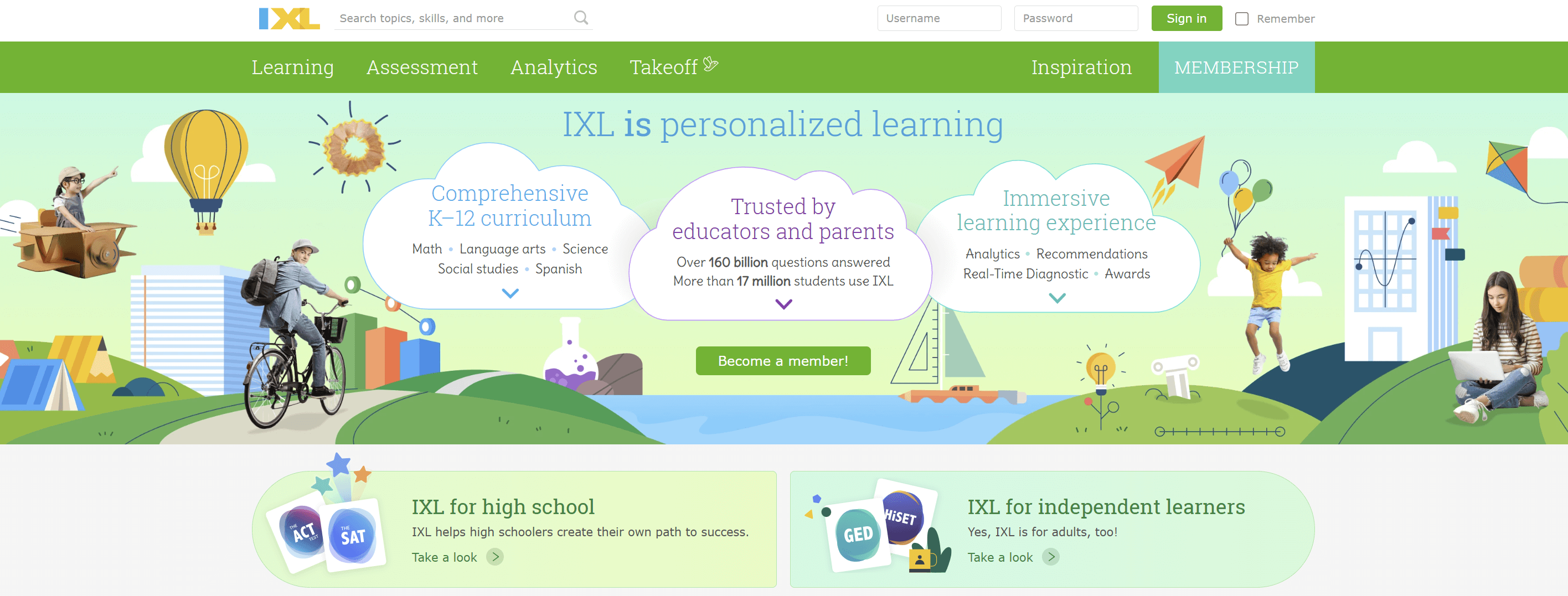
As shown by the IXL review, this platform is a good tier 3 research based math interventions resource for students across all grade levels. It supplies a comprehensive math curriculum with immersive, personalized learning based on prerecorded videos and practice questions.
IXL math intervention resources: Features
- Full math curriculum
- A myriad of practice problems
- Real-time analytics
IXL pricing
The IXL cost for a single subject (math) is $9.95/month. There is a 30-day satisfaction guarantee, and you can cancel IXL subscription at any point.
IXL pros |
IXL cons |
| ✅Wide range of topics covered | ❌Repetitive math practice questions |
| ✅Appropriate for all grade levels | ❌Less focus on instruction |
| ✅Alignment with US state standards | ❌Problematic grading system |
#6 XtraMath intervention math curriculum
Age group: K-8 grade
Best for: Building basic math fact fluency across grade levels
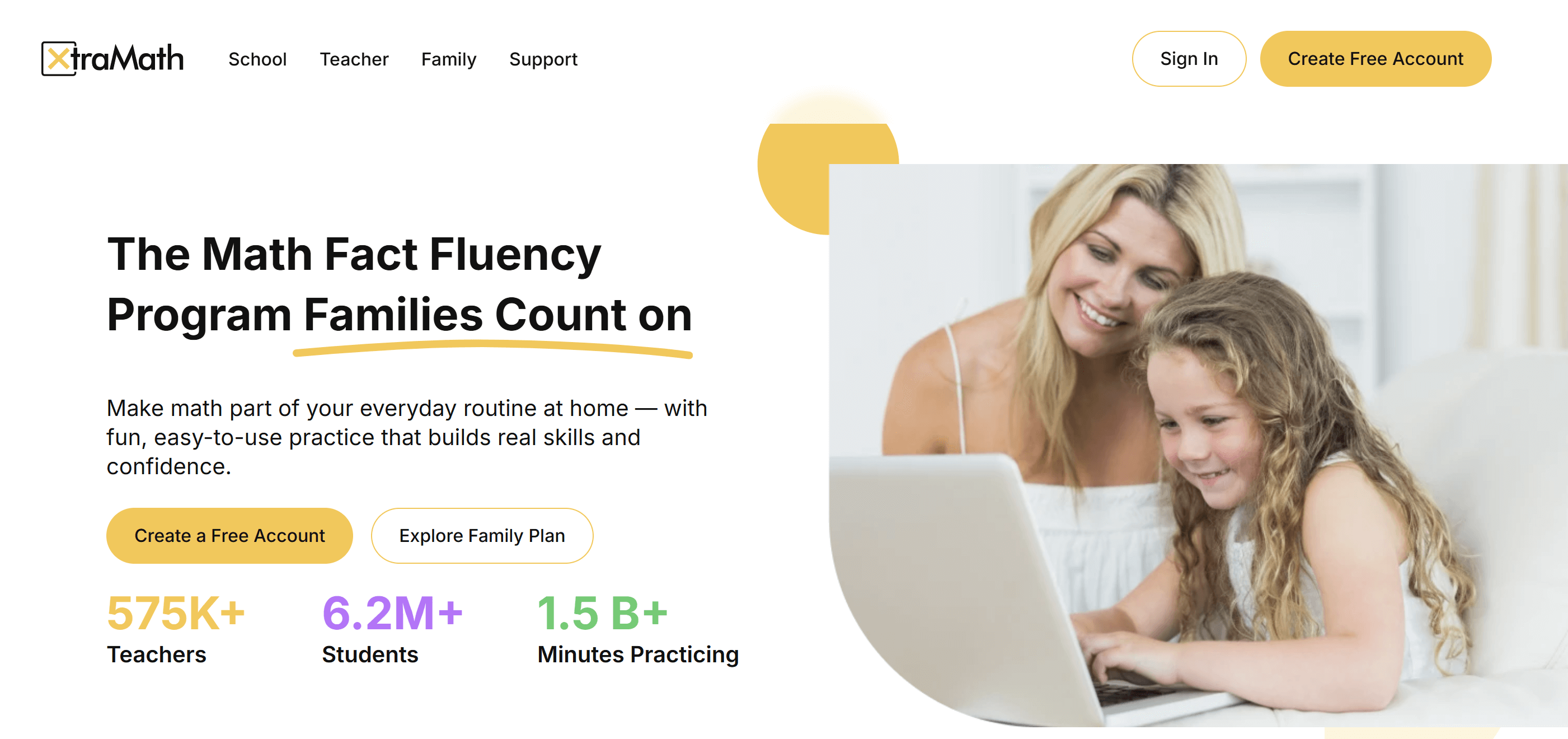
XtraMath is one of the free math intervention programs for elementary school through middle school. This online learning platform emphasizes the automatic recall of basic facts through intensive repeated practice.
XtraMath features
- Adaptive math practice
- Instant feedback on solved problems
- Student awards for motivation
XtraMath pricing
The premium XtraMath family plan costs $2/year, which is basically free. An entirely free version is also available.
XtraMath pros |
XtraMath cons |
| ✅Focus on math fluency | ❌No real teaching |
| ✅Requires 10 minutes/day | ❌Limited focus on teaching addition, subtraction, multiplication, and division |
| ✅Simple-to-use platform | ❌Less engaging than other program options |
#7 Pirate Math Equation Quest
Age group: 3rd grade
Best for: Word-problem intervention for elementary school students struggling with story problems
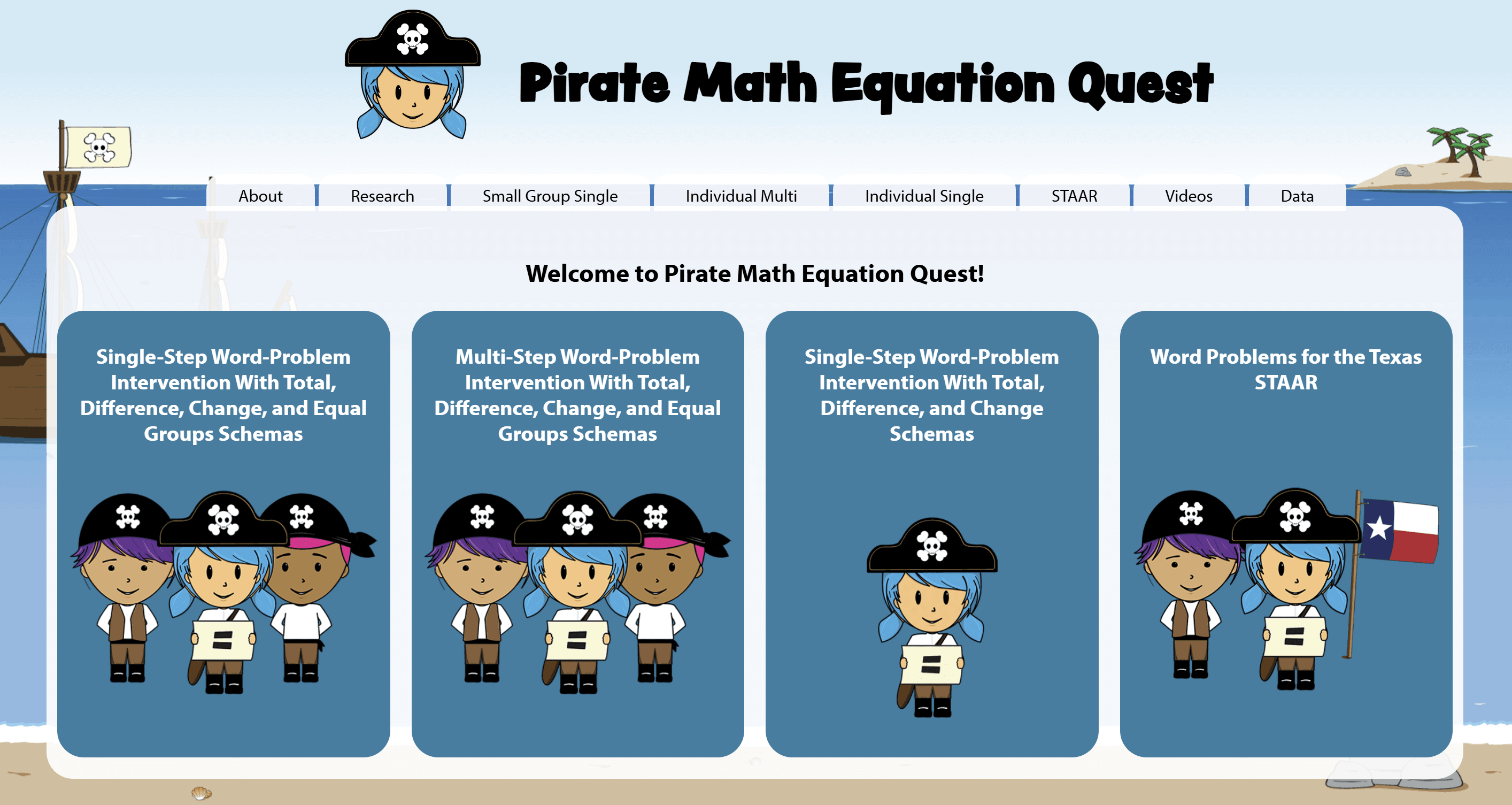
Pirate Math Equation Quest is one of the research based math intervention programs focused on solving math word problems for kids through a step-by-step process. It provides structured materials for parents and teachers to work with kids who need support.
Pirate Math Equation Quest intervention program in mathematics: Features
- Word-problem schemas
- Well-organized strategies
- Design for elementary school math
Pirate Math Equation Quest pricing
Pirate Math Equation Quest offers instructional videos and practice materials in PDF format for free. Parents might incur printing or copying costs.
Pirate Math Equation Quest pros |
Pirate Math Equation Quest cons |
| ✅Word-problem focus | ❌Limited type of mathematics problems |
| ✅Perfect match for grade 3 | ❌Prerecorded instructional videos |
| ✅Free resources | ❌Requires strong parent or teacher involvement to produce results |
Although this platform can provide a good supplementary practice for the specific age, it can still be challenging for students who lack motivation.
#8 Khan Academy math intervention program
Age group: PreK-12 grade
Best for: Self-paced video lessons and practice for all ages and levels
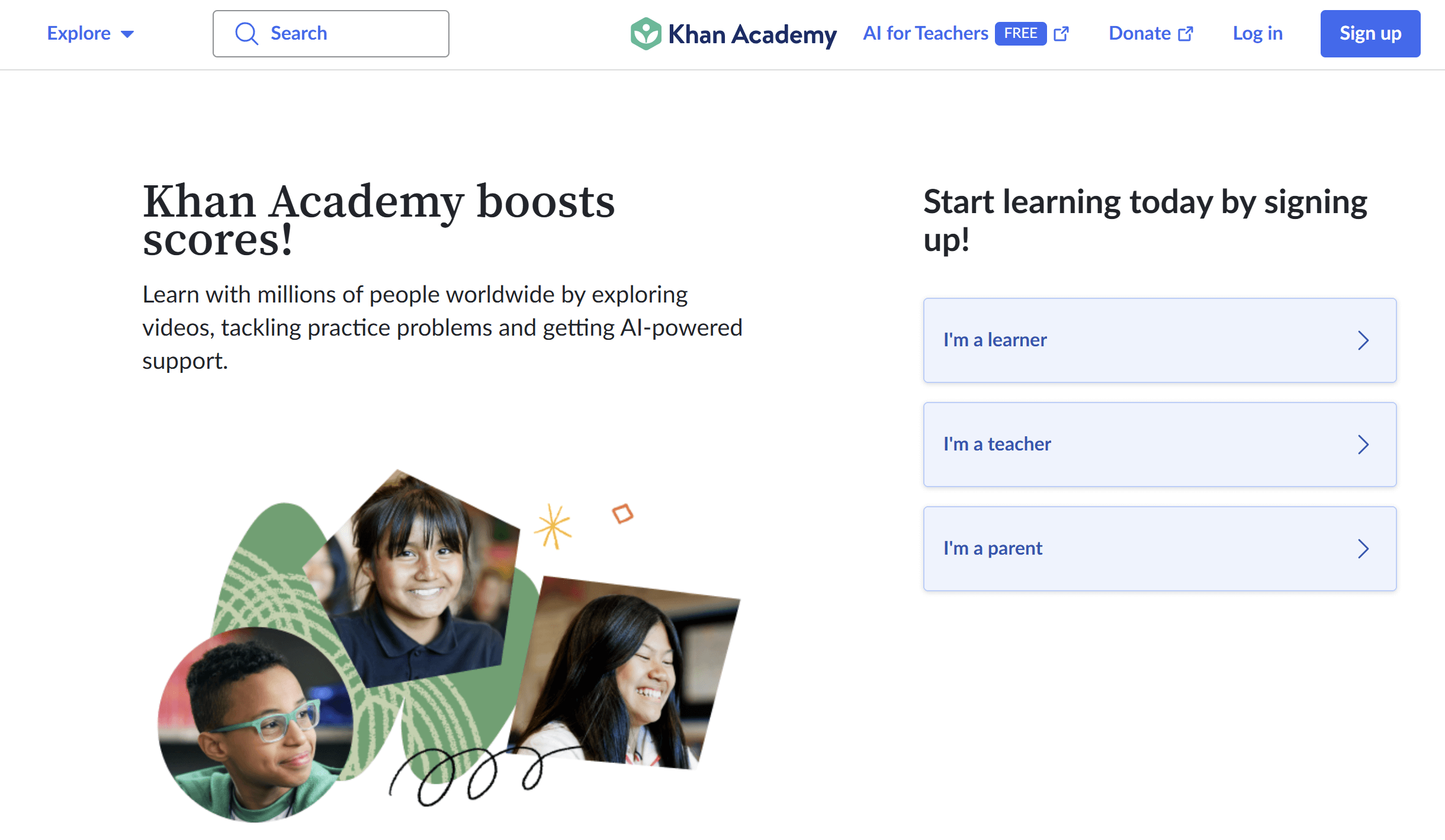
Khan Academy reviews point out that it’s one of the most widely used evidence-based math intervention programs that covers all grade levels. It provides prerecorded video explanations and adaptive math practice for free.
Khan Academy free math intervention programs: Features
- Prerecorded video lessons
- Diverse practice opportunities
- Progress monitoring
Khan Academy pricing
Khan Academy is absolutely free of charge.
Khan Academy pros |
Khan Academy cons |
| ✅Comprehensive math intervention curriculum plus reading, sciences, and more subjects | ❌No interaction with live teachers |
| ✅Full grade and age coverage | ❌Requires self-motivation |
| ✅Totally free platform | ❌Limited instruction personalization |
#9 Mathlinks: Essentials
Age group: 6-9 grade
Best for: Modular math intervention in middle school
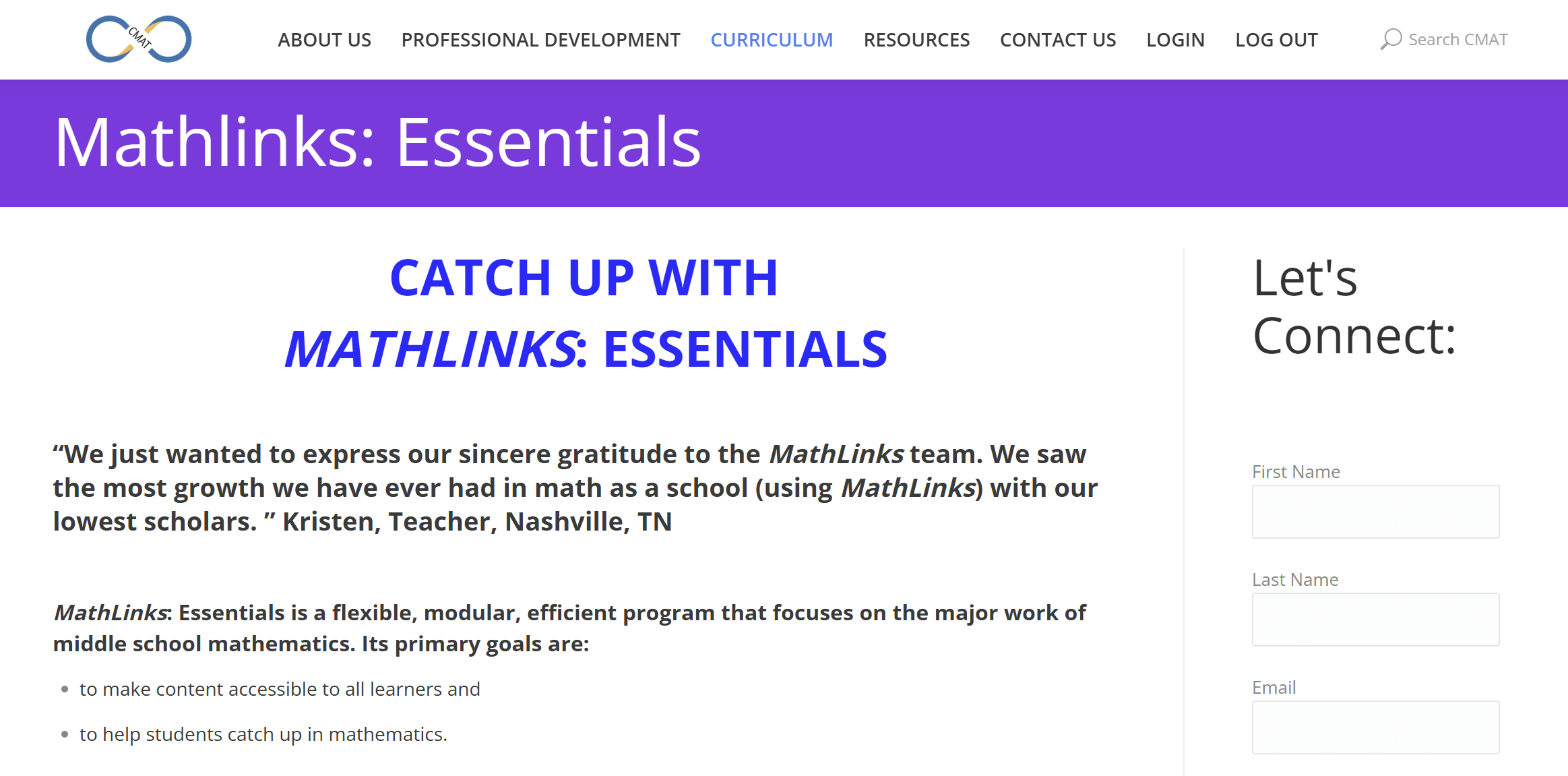
Mathlinks: Essentials is one of the well-known tier 2 math intervention programs. It’s based on a flexible, modular approach that aims to make math concepts understandable for all students and allows them to catch up with peers.
Mathlinks: Essentials features
- Grade-organized packages
- Targeted intervention based on specific needs
- Research-based math intervention strategies
Mathlinks: Essentials pricing
Mathlinks: Essentials is usually implemented by schools and districts at zero cost for families.
Mathlinks: Essentials pros |
Mathlinks: Essentials cons |
| ✅Works for children with diverse | ❌Limited grade coverage |
| ✅Clear lesson structure | ❌Needs parent or teacher devotion |
| ✅Appropriate for special education needs | ❌Limited interactive activities |
#10 Freckle math intervention program
Age group: K-12 grade
Best for: Adaptive problem-solving practice for all grade levels

Freckle, by Renaissance, is among the best remediation math programs offering adaptive learning. It focuses on math practice that gets customized in real time to help children work on the exact skills where they face the most issues.
Freckle intervention program in mathematics: Features
- Adaptive practice
- Alignment with US state standards
- Progress dashboards
Freckle pricing
The Freckle parent account is free.
Freckle pros |
Freckle cons |
| ✅70,000+ unique math questions | ❌No comprehensive curriculum |
| ✅Personalized skills practice | ❌No teacher instruction |
| ✅Home and school availability | ❌Requires parent or teacher support |
Are there any math intervention programs for special education?
Intervention math programs that work for special education include MobyMax, IXL, and Mathlinks: Essentials. While other programs, such as Brighterly, offer highly personalized learning plans to support students with learning difficulties, like ADHD, they don’t have IEP goal tracking.
What are the best elementary math intervention programs?
The best math intervention programs for elementary school students are Brighterly, DreamBox, XtraMath, Pirate Math Equation Quest, and Khan Academy. The individualized approach, gamified models, adapted math questions, and user-friendly interface make them a perfect match for young learners.
What are the best middle school math intervention programs?
The best math intervention programs for middle school students include Brighterly, MobyMax, and Mathlinks: Essentials. The platforms provide targeted support to help struggling children better understand math concepts and apply them to solve problems. The delivery method is appropriate for this age group.
What are the best high school math intervention programs?
The best online math intervention programs for high school students are Brighterly (grade 9), Mathnasium, IXL, and Freckle. The learning method applied by these websites is the right fit for older children who are still facing troubles with math. They offer a mix of instructions and practice for comprehensive learning.
Mathematics intervention programs: Which one to choose?
These are the top math intervention programs for elementary, middle, and high school. They come with many different features, strengths, and weaknesses, meaning that each family can select the one that best fits their particular situation. Which one you get for your child depends on their specific needs, learning gaps, preferred learning method, and your budget.
- If your situation allows you to spend some extra money on targeted math support, you can look into DreamBox, MobyMax, Mathnasium, or IXL.
- If you’re looking for free math intervention programs, you can check out XtraMath, Pirate Math Equation Quest, Khan Academy, Mathlinks: Essentials, or Freckle.
- If you want to help your child develop math knowledge alongside confidence, Brighterly is the right option for you.
With the Brighterly reading and math intervention programs, your child gets:
✅1:1, personalized math tutoring
✅Access to professional, highly qualified math tutors
✅Free supplementary math resources
Ready to give your kid the support they deserve? Book free lesson now to get started with math excellence.


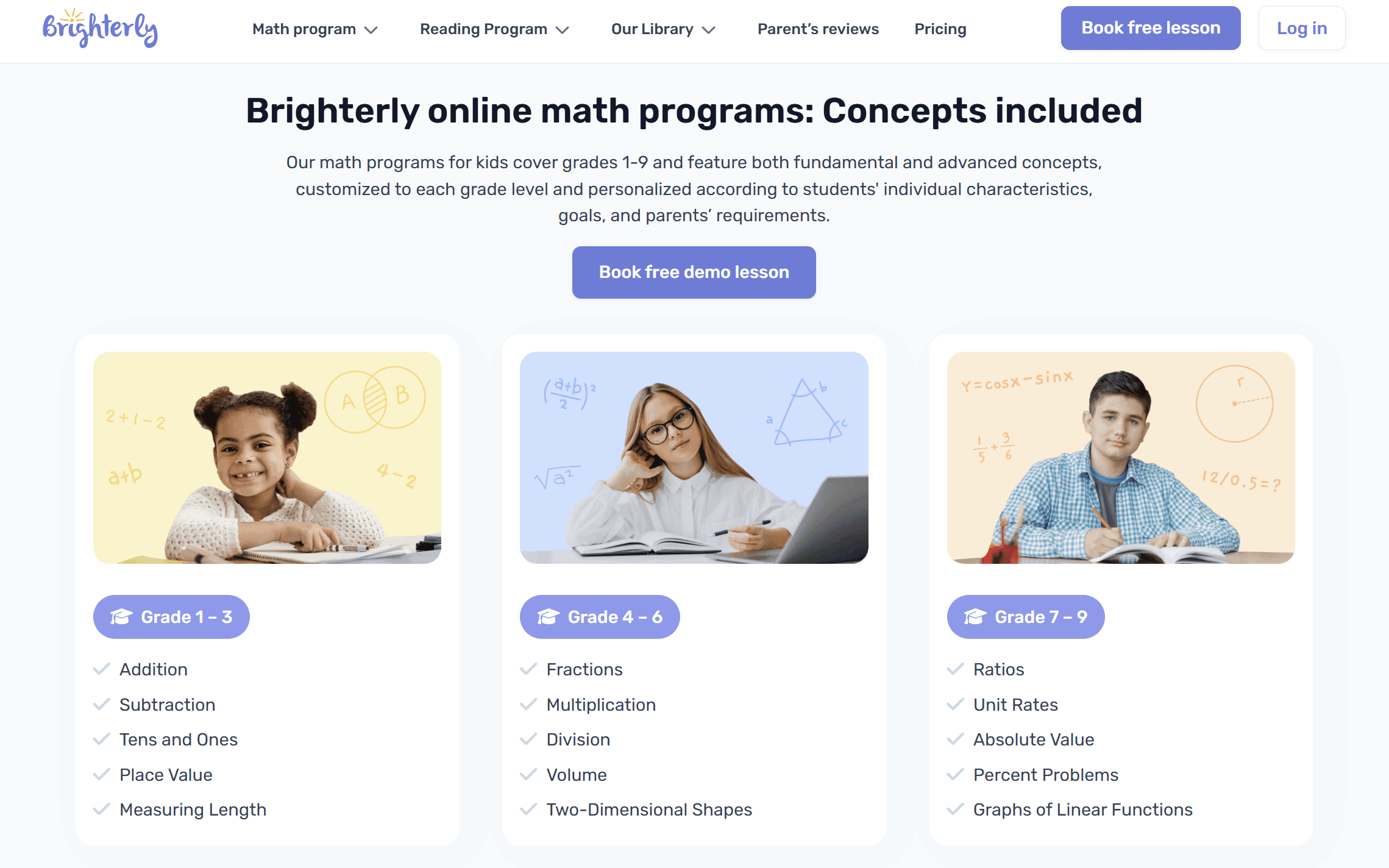







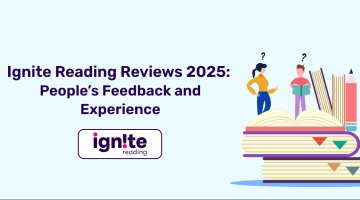

![Learner Tutoring Reviews: Pros, Cons, and User Ratings [2025]](https://brighterly-stage.xyz/wp-content/uploads/2025/07/Learner-Tutoring-Reviews_-Pros-Cons-and-User-Ratings--360x200.png)



